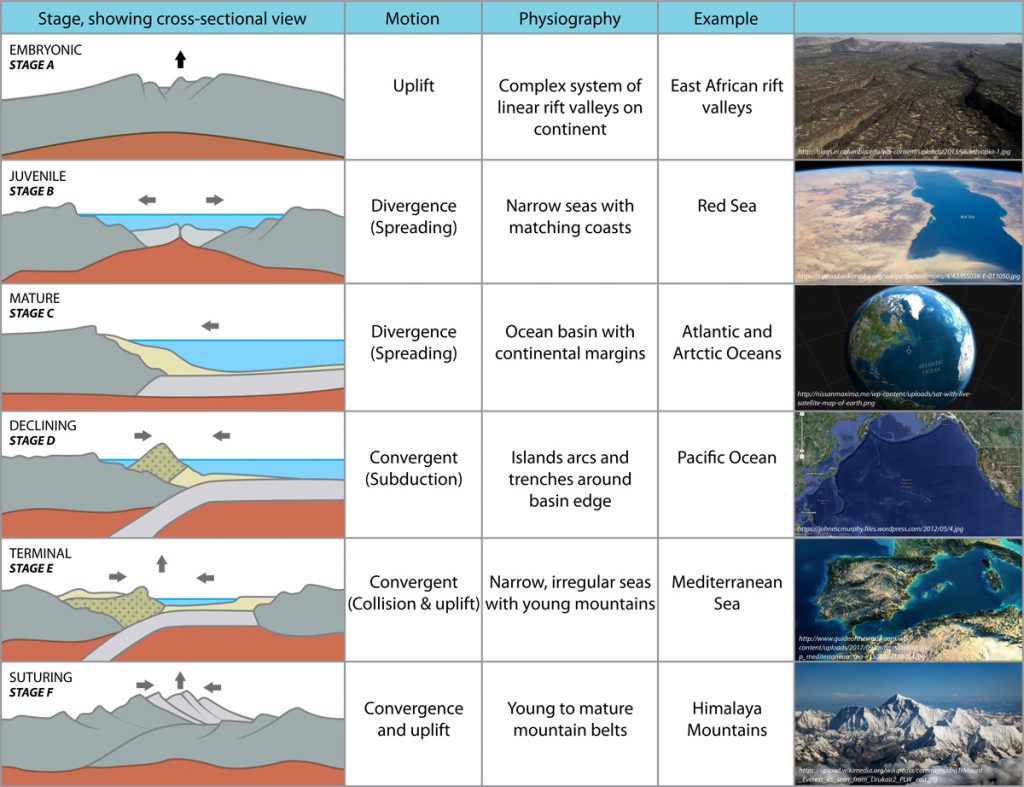Wilson cycle
The Wilson Cycle explains the process of the opening (beginning) and the closing (end) of an ocean.
The processes, is driven by Plate Tectonics. A simple explanation of the Wilson cycle includes two phases, the Opening phase and a Closing phase, explained below in Stage A to F (figure 1). The Wilson cycle, is named after the Canadian geophysicist J. Tuzo Wilson (1908-1993). The Wilson cycle is divided into 6 stages. 1. Embryonic Ocean Basin, 2. Juvenile Ocean Basin, 3. Mature Ocean Basin, 4. Declining Ocean Basin, 5. Terminal Ocean Basin and 6. Suturing (Continental collision).
Embryonic Ocean Basin (Stable Craton with a hot spot underneath) Stage A:
At first, there is a stable Continental Craton, which has a hot spot just underneath. This warm hot spot heats up the craton (continent) and causes it to swell upwards and in the breakup zone the continental crust gets thinner and thinner and starts to crack, which eventually causes the continent to break into two continents and a small ocean will with time form in the middle. The East African rift Valley is an example of stage A.
Juvenile Ocean Basin (Early Rifting of a Continent) Stage B:
Now the spreading of earth plates starts and a small ocean has formed between the newly broken up continents. As the continents continue to drift apart, the edges of both continents will cool down and therefor get heavier and sink below the newly formed sea. This boundary is called a divergent boundary. The Red Sea is an example of stage B.
Mature Ocean Basin (Full ocean basin) Stage C:
Stage C, is when a large ocean has formed between two continental margins and spreading still occurs.
A well developed mid ocean ridge has formed along the divergent boundary. The Atlantic Ocean is an example of stage C.
Declining ocean basin (Subduction Zone) Stage D:
At this stage, a subduction zone has formed and the ocean begins to close up. One of the simplest ways a subduction zone forms is at the edge of a continent, where one tectonic plate is subdued below another tectonic plate. This is a convergent boundary and eventually the ocean will disappear and all that is left is a remnant ocean basin. The Pacific Ocean is an example of stage D.
Terminal Ocean Basin (Closing Remnant Ocean Basin) Stage E:
At this stage, the continents are almost colliding. Formation of magma happens deep in the subduction zone and small mountains are building up. In the subduction zone both metamorphism (change in the rocks composition), folding (the earth layers are “bending”) and faulting (the earth crust cracks) occurs. The boundary is convergent and the sea is at this stage narrow and irregular. An example of stage E is the Mediterranean Sea.
Suturing (Continental Collision) Stage F:
This is the final stage, before the mountain chain eventually will erode down to a peneplain (that’s when the mountains have eroded all the way down to the sea-level). At stage F, the two continents moving towards each other will collide and a mountain chain forms. An example of this stage is the Himalaya Mountains.



 This project (EDU-ARCTIC) has received funding from the European Union’s Horizon 2020 research and innovation programme under grant agreement No 710240. The content of the website is the sole responsibility of the Consortium and it does not represent the opinion of the European Commission, and the Commission is not responsible for any use that might be made of information contained.
This project (EDU-ARCTIC) has received funding from the European Union’s Horizon 2020 research and innovation programme under grant agreement No 710240. The content of the website is the sole responsibility of the Consortium and it does not represent the opinion of the European Commission, and the Commission is not responsible for any use that might be made of information contained.